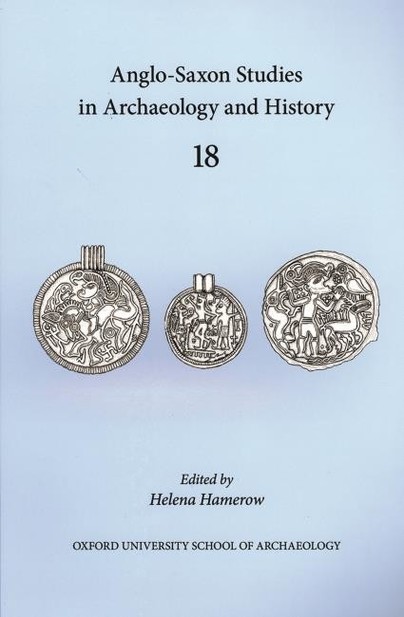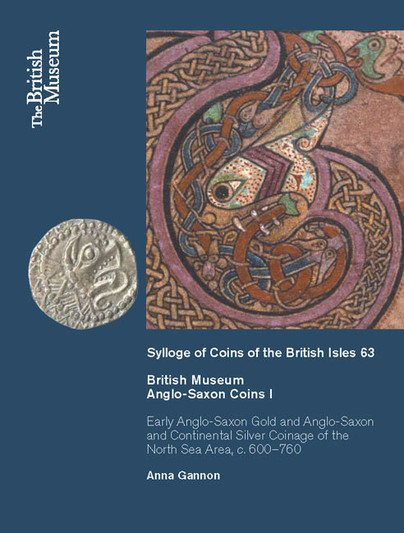
Format: Hardback
Pages: 304
ISBN: 9780714118239
Pub Date: 05 Aug 2013
Description:
This volume is dedicated to the British Museum’s collection of early Anglo-Saxon gold coinage as well as the Anglo-Saxon and Continental silver coinage of the North Sea area, dating from the early seventh to the mid-eighth centuries. This was the coinage which circulated during the age of Bede, the Lindisfarne Gospels and Sutton Hoo, and which is widely celebrated for its historical significance and artistic accomplishment. Both these features are well illustrated in this volume by more than 850 coins, which together form one of the largest, oldest and most representative collections of this complex coinage.
The last catalogue of this part of the British Museum’s collection was published in 1887 and since then the collection has more than tripled in size. This new catalogue includes comprehensive coverage of all new acquisitions, among them material from several significant hoards, as well as full details on the provenance and identification of individual coins. A major introduction sets the coins in context and reassesses their classification. New metallurgical analyses of the gold coinage and authoritative interpretation of the results, as well as a survey of the history of the collection, constitute further valuable supplements to the catalogue.
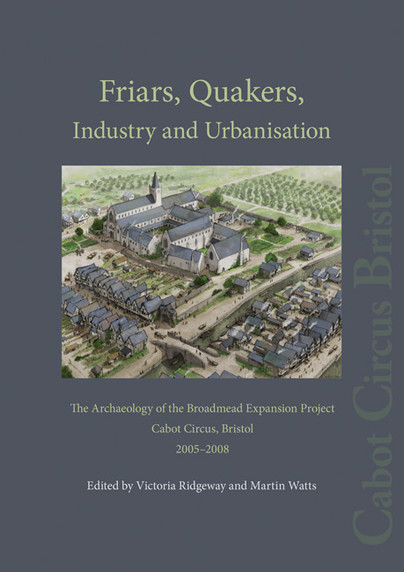
Format: Hardback
Pages: 450
ISBN: 9780956305480
Pub Date: 31 Jul 2013
Description:
The development of Cabot Circus shopping centre presented a rare opportunity for the archaeological investigation of a large part of the Broadmead suburb of Bristol. The former presence of a Dominican Friary and later Friends’ Meeting House were already well known, and surviving buildings from both remain within a large open piazza in the west of the new development. Further elements of the friary complex, including remains of the church and two cloisters, were revealed in various archaeological interventions within the area of the former precinct, enabling a reconstruction of the precinct and its environs to be made.
The project has also shed light on other aspects of the suburb’s past that were previously less well known. Borehole investigations have allowed the prehistoric environment of the River Frome valley to be characterised, with episodes of small-scale tree clearance from the surrounding slopes during the later Neolithic and early Bronze Age, and the floodplain remaining as mud flats until the development of the Broadmead suburb in the 12th century and the arrival of the Dominicans in the 13th century. River access and the presence of flowing water were important assets for the industrial medieval and later suburb, which was home to tanning, leatherworking, ironworking and cloth industries. The Dissolution saw the demolition of parts of the friary, and by the later 17th century the surviving claustral buildings were occupied by trade guilds and the Quakers had built their first Meeting House. The 18th and 19th centuries were times of enormous expansion for Bristol, when large-scale development occurred, expanding the suburb to the north and east of the former friary. These new developments included industrial premises, saw mills, cabinet works and malthouses, alongside terraces and courts of domestic dwellings. The recovery of a significant assemblage of tobacco pipe bowls and kiln wasters has enabled the development of new typology for Bristol, which should prove invaluable in dating future assemblages recovered from the city.

Format: Paperback
Pages: 120
ISBN: 9781907586170
Pub Date: 30 Jun 2013
Series: MoLAS Archaeology Studies Series
Description:
Excavations on the south side of Cheapside found evidence for Roman timber buildings and pits dating to the later 1st and 2nd centuries AD, and a masonry building constructed after c AD 125. The main west–east road through Londinium lay immediately north of the site. Evidence for later Roman occupation was limited by modern truncation.
No medieval ground surfaces survive, but the site was reoccupied from the 10th century with at least one substantial building existing by the 13th century. Pit and well groups include late 13th- or early 14th-century vessels associated with the wine trade and early 14th-century kitchenware.
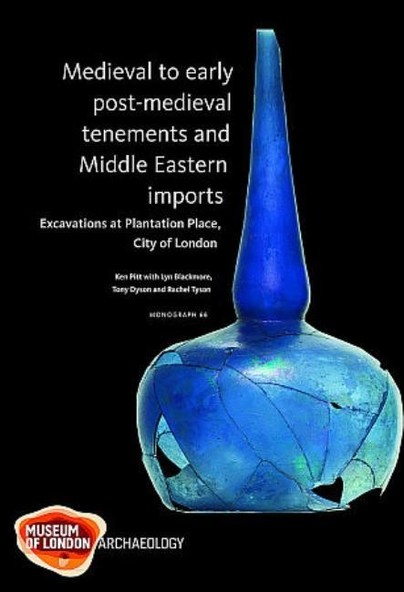
Format: Hardback
Pages: 140
ISBN: 9781907586163
Pub Date: 30 Apr 2013
Series: Monograph Series
Description:
Excavations at Plantation Place provided evidence for medieval and early post-medieval occupation of an entire block in the eastern part of the City of London near the Thames waterfront. Contemporary ground surfaces and buildings did not survive, but associated pits and wells have been related by documentary and cartographic research to identified tenements in this thriving area of shops, warehouses and merchants’ residences. Important assemblages from pits and wells include vessels used in refining gold, crucibles and moulds from bronze casting, and the largest assemblage of late medieval Islamic-style glass yet found in Britain, alongside Middle Eastern ceramics.
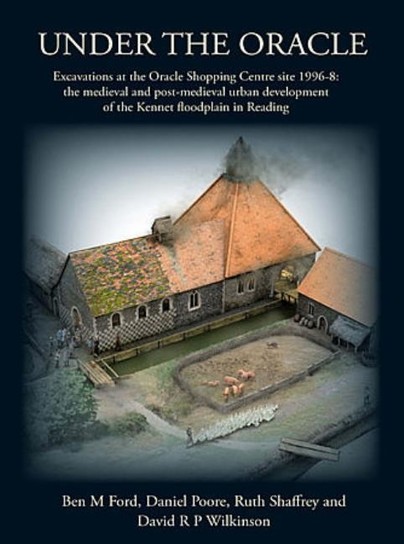
Format: Hardback
Pages: 340
ISBN: 9781905905270
Pub Date: 01 Apr 2013
Series: Thames Valley Landscapes Monograph
Description:
Excavations carried out by Oxford Archaeology in advance of the building of the Oracle shopping centre revealed a long sequence of development of the Kennet floodplain at Reading. This volume reports on the substantial evidence recovered for medieval and post-medieval water management, milling at the Minster Mill and St Giles Mill, the tanning, leather working and dyeing industries, and an unusual building interpreted as the 12th- to 13th-century cookhouse of Reading Abbey. The stories of two well-known Reading sites, the Oracle Workhouse and the Yield Hall, are followed from the medieval period up to the 19th century.
Substantial specialist reports include pottery, glass, leatherworking, dendrochronology and clay pipes.
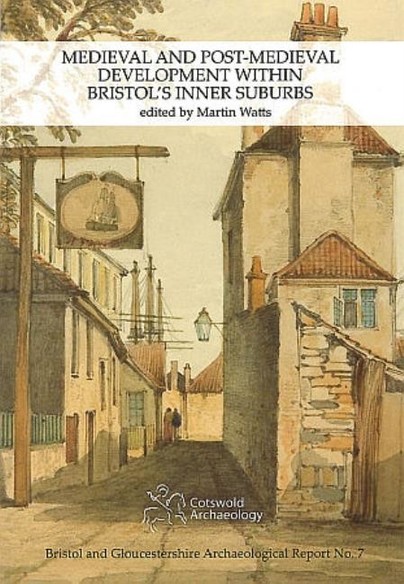
Format: Paperback
Pages: 144
ISBN: 9780955353444
Pub Date: 31 Mar 2013
Illustrations: 13 b/w and 41 colour illustrations
Description:
This volume contains the results of four archaeological projects undertaken within the historic suburbs of Bristol. Excavations at nos 26–28 and at nos 55–60 St Thomas Street were both within the 12th-century planned suburb of Redcliffe, just to the southeast of the medieval city. Investigations at Harbourside and at Cabot House, Deanery Road, were undertaken in the medieval district of Billeswick, to the southwest of the city centre and in the vicinity of Bristol Cathedral, formerly the church of the 12th-century St Augustine’s Abbey.
However, it is the general lack of evidence for significant development at these sites throughout the medieval and post-medieval periods and up to the beginning of the 18th century that provides a common theme.The scarcity of evidence for medieval and post-medieval development at the Billeswick sites, Cabot House and Harbourside, is unsurprising as both were in the ownership of the abbey or cathedral throughout this period, and were clearly of value as undeveloped land, either as parkland (as at Cabot House) or meadow (i.e. Canon’s Marsh at Harbourside). The dearth of evidence from the St Thomas Street sites in Redcliffe was more unexpected, though this appears to corroborate documentary evidence suggesting that this part of the suburb remained something of a backwater into late post-medieval times. At nos 55–60, there was little evidence for anything more substantial than simple boundaries and timber structures, perhaps used for drying cloth, until the beginning of the 18th century. At nos 26–28 there was no evidence for tenements until late into the post-medieval period and the site may well have been part of a medieval grange. The development of the first substantial buildings at both St Thomas Street sites, of new streets and terraces at Cabot House, and of the ropewalks and later industrial development of Canon’s Marsh at Harbourside, all reflect the rapid expansion and building boom Bristol enjoyed in the 18th century, largely a result of the city’s involvement in the Atlantic trade.
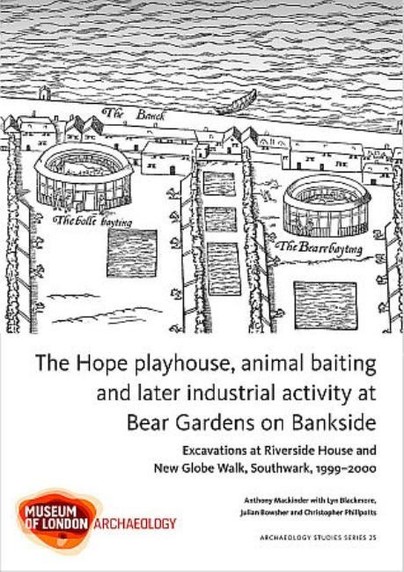
Format: Paperback
Pages: 94
ISBN: 9781907586200
Pub Date: 31 Mar 2013
Series: MoLAS Archaeology Studies Series
Description:
Southwark’s famous Bankside was long known as an entertainment area up to the 17th century. This volume provides evidence for the Barge, one of the medieval stewhouses (tavern/brothel) and the later Hope, a dual purpose building hosting animal baiting as well as play performances. The next phase in Bankside’s history was industrial and its glass and pottery products of the 17th and 18th centuries were much sought after.
Evidence for their production was found on the sites. The remains of 19th-century brick buildings relate to a known iron foundry in the area.

Format: Paperback
Pages: 384
ISBN: 9781480216440
Pub Date: 18 Mar 2013
Imprint: Jules William Press
Series: Viking Language Old Norse Icelandic Series
Description:
Viking Language 1: Learn Old Norse, Runes, and Icelandic Sagas (the first book in the Viking Language Series) is a new introduction to Old Norse and Icelandic. The beginner has everything in one book: Graded lessons, reading passages, vocabulary, grammar exercises, and pronunciation. A full complement of maps, runic inscriptions and culture sections explore the civilization, legends, and myths of the Vikings.
The lessons follow an innovative word frequency strategy, a method that speeds learning. Because the grammar of Modern Icelandic has changed so little from Old Norse, the learner is well on the way to mastering Modern Icelandic.

Format: Paperback
Pages: 113
ISBN: 9780983854654
Pub Date: 04 Jan 2013
Imprint: Les Enluminures
Illustrations: 40 illus.
Description:
Throughout the history of Christianity, men and women have wrestled with the challenge of how to interpret, and how to follow, the Gospels. Intrinsic to this process is the concept of "reform", a recognition that changes is necessary in order to return to a more authentic Christian life. The approximately thirty-five manuscripts presented here trace this process from the twelfth to the sixteenth centuries through the texts that inspired reform movements and communicated their ideas to others.

Format: Paperback
Pages: 496
ISBN: 9781842174784
Pub Date: 30 Nov 2012
Illustrations: b/w illus throughout
Description:
Our recent understanding of British history has been slowly unravelling thanks to new techniques such as DNA analysis, new archaeological data and reassessment of the literary evidence. There are considerable problems in understanding the early history of Britain; sources for the centuries from the first Roman invasion to 1000 AD are few and contradictory, the archaeological record complex and there is little collaboration or agreement between archaeologists, Roman and Anglo-Saxon historians. A common assumption concerning the development of the English language and, therefore British history, is that there was an invasion from northern Europe in the 5th century, the so-called Anglo-Saxon migration; a model based on the writings of Bede.
However the Bedan model has become increasingly unsustainable and is on the verge of collapse. Myth and History offers a comprehensive re-assessment of the present scientific, historical, archaeological and language evidence, debunking the model of British history based on Bede, and showing how Roman texts can be used in conjunction with the other evidence to build an alternative picture. Stephen Yeates demonstrates that the evidence that has been used to construct the story of an Anglo-Saxon migration, with an incoming population replacing most, if not all, of the British population has been found wanting, that initial attempts to interpret literally the DNA evidence based on historical sources are problematic, and that the best DNA analysis of the British Isles fits the evidence into a broader European view which attempts to plot the movement of people across the Continent and which sees the major migration periods in Europe as occurring in the Mesolithic and the Neolithic. This DNA analysis is constant with the latest assessments based on language development, contemporary historical reports from the Roman period, and the analysis of archaeological data from the Iron Age and Roman period. He also argues that the Roman texts can be used to identify where the Late Roman provinces of Britain actually lay and this leads to important conclusions about the ethnicity and origins of the early British peoples. This book is a timely attempt to unravel myth from history, present a cogent platform for Anglo-Saxon studies and understand who the British people really are.

Format: Hardback
Pages: 350
ISBN: 9781907586149
Pub Date: 31 Oct 2012
Series: MoLAS Monograph
Description:
The development of the major settlement of Lundenwic in the late 7th century AD marked the rebirth of London as a town. In the following century the emporium served as a seaport for the landlocked kingdom of Mercia and played a significant role in the maritime trade of north-west Europe. This monograph provides the first detailed overview of the archaeological evidence for the trading port, placing it in its regional, national and international context.
The results of fieldwork at 18 locations on the site of the former Middle Saxon settlement are followed by essays on various aspects of the settlement, including its geographical setting, activity pre-dating Lundenwic (which includes one or more cemeteries), the development, size and layout of the emporium, food production and consumption, crafts and industry, trade, dress and religion. The final section focuses on finds assemblages recovered from the settlement, including ceramics, glass, metal, and bone and antler artefacts, as well as human, animal and plant remains. Radiocarbon dates interpreted by Bayesian modelling are found to broadly accord with archaeological evidence for rapid settlement growth in the third quarter of the 7th century AD, and the first use of Ipswich ware (an important chronological marker) in London c AD 730. The volume also includes a gazetteer of sites and a timeline for the settlement and its hinterland.

Format: Hardback
Pages: 358
ISBN: 9781902937618
Pub Date: 01 Oct 2012
Series: McDonald Institute Monographs
Illustrations: Illus.
Description:
Quoygrew - a settlement of farmers and fishers on the island of Westray in Orkney - was continuously occupied from the tenth century until 1937. Focusing on the archaeology of its first 700 years, this volume explores how 'small worlds' both reflected and impacted the fundamental pan-European watersheds of the Middle Ages: the growth of population, economic production and trade from the tenth to the thirteenth centuries and the subsequent economic and demographic retrenchment of the fourteenth to fifteenth centuries. Concurrently, it addresses the nature of island societies, with distinctive identities shaped by the interplay of isolation and interconnectedness.

Format: Hardback
Pages: 184
ISBN: 9781842174845
Pub Date: 28 Sep 2012
Illustrations: b/w and colour illustrations
Description:
The excavation of an area within the grounds of the Prebendal, Aylesbury, Buckinghamshire, adjacent to the parish church of St Mary's, showed that the town, which lies on a slight spur, is sited within a univallate Iron Age hillfort. Early-Middle Iron Age activity included the creation of a notable ritual area contaning the burials of four children and a young woman, most accompanied by animals; and a 'bone mass' containing animal bone, mostly disarticulated. Within a generation or so of the deposit's creation, within the first half of the 4th century BC, a univallate hillfort was constructed which did not continue into the later Iron Age.
Early in the Middle Saxon period a palisade trench was dug into the hillfort's ditch, which was replaced by a ditch in the 8th century. Both palisade and ditch were almost certainly the boundaries of an early minster church and it is very likely that the former existence of the hillfort influenced its siting here. An unusual piece of Merovingian glass with a moulded cross on its base is likely to have been one of the minster's possessions. The extensive minster cemetery and later Saxon development of the town is briefly noted. A significant Saxo-Norman grain deposit which has been radiocarbon dated to the 11th-12th centuries is described.

Format: Paperback
Pages: 250
ISBN: 9781907586125
Pub Date: 30 Jul 2012
Description:
This guide to the unique theatrical venues of London, from 1567, when the first playhouse was built, to 1642, when Cromwell closed them down, sets out the rich dramatic history of this period in relation to the latest exciting archaeological evidence. The book also details the people involved - the builders, actors, playwrights and audiences - what they wore and what they ate, where they drank, where they fought, where they lived and died. There are theatrical quotes and jokes, and illustrations old and new, while a series of walks explores different areas of today's London, where glimpses of Shakespeare's London can still be caught.

Format: Hardback
Pages: 224
ISBN: 9781842174654
Pub Date: 15 Jun 2012
Illustrations: col & b/w illus
Description:
For many decades in the 18th and 19th centuries, Russia was the world's greatest exporter of flax and hemp and Great Britain its major customer. Most studies of flax and hemp and their associated industries have hitherto concentrated on the economic and historical events surrounding the rise and fall of these industries in Britain. This book is based on a large body of new material consisting of lead-alloy seals that were attached to bundles of flax and hemp exported from Russia and aims chiefly to describe the different seals that were used and to explain the reasons why they were employed.
It offers a short history of their use, a guide to their identification and a catalogue of items recovered in Britain, opening up a valuable new source of material for analysing a different aspect of the history of commercial relations between Russia and Britain and providing assistance for finders and museum curators in identifying and deciphering these objects correctly. The text guides the reader through the different types of seal so far recorded using illustrations, transliterations of the Cyrillic texts found on the seals and explanatory tables, as well as a comprehensive catalogue. Analysis is conducted of the information found in the seals. This information provides us with a picture of the manner in which the export of these products from Russia to Britain was handled and allows us to make comparisons over different periods of time and to analyse the different systems of quality control used. It also enables us to record the geographical distribution of Russian ports used for the export of flax and hemp to the UK, where the spread of their distribution tells us something of the redistribution of these imports and provides an understanding of the use to which their by-products were put as part of the agricultural practices of the 18th and 19th centuries.



